Learn about the Broadband Internet Information Label
Like food nutrition labels, the Broadband Internet Label provides transparency and clarity around the internet services you're planning to purchase. As of April 10, 2024, the Federal Communications Commission (FCC) requires all internet providers to display their product information in this label format.
The standardized format will allow for direct comparison between providers, so you can find the best option for your needs and feel confident in your decision.
On this page, you can find a line-by-line explanation of the label, see key terms and definitions, read answers to frequently asked questions, and download a machine-readable catalog of the label.
CenturyLink Broadband Label, line by line
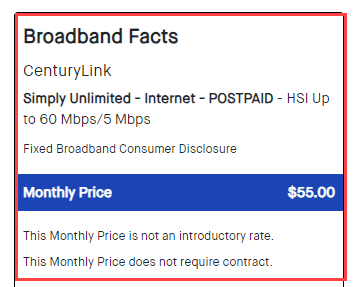
Broadband facts
This is where you can find the name of your internet service provider, service plan and/or speed tier, and whether your plan is fixed or mobile. You can also see your monthly price, whether it's an introductory rate or not, and the length of any applicable contracts for that rate.
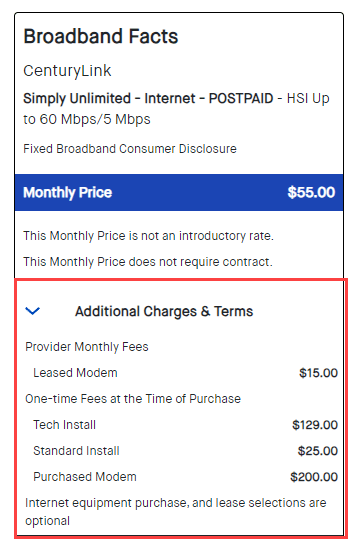
Additional charges and terms
Here you’ll see a breakdown of additional charges that apply to your plan such as monthly and one-time fees, early termination, and taxes.
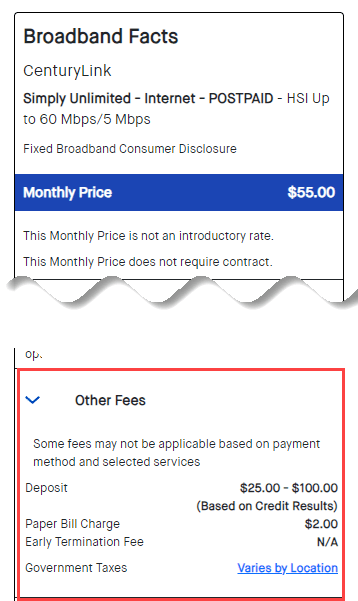
Other fees
In this section, you’ll find additional recurring fees that may apply to some customers based on the selections that they’ve made at time of purchase.
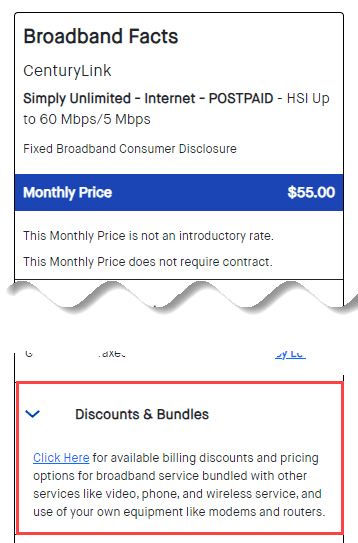
Discounts and bundles
In this section, you’ll find a link that will show you available billing discounts and pricing options for your plan.
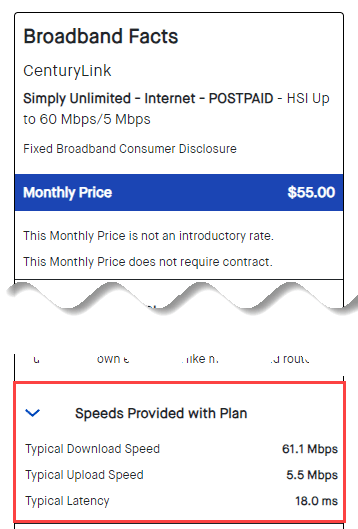
Speeds provided with plan
Here you can see your plan's typical download speed, upload speed, and latency (the amount of time it takes for data to travel from its original source to its destination). You can use this section to get a clear view of the expected performance of your service.
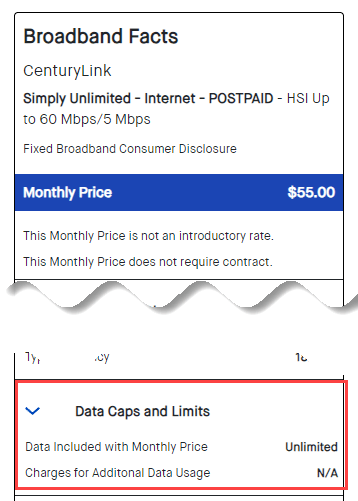
Data caps and limits
In this section, you'll see any data usage caps that apply to your plan. You can also see what charges you might incur if you go over your monthly limit.
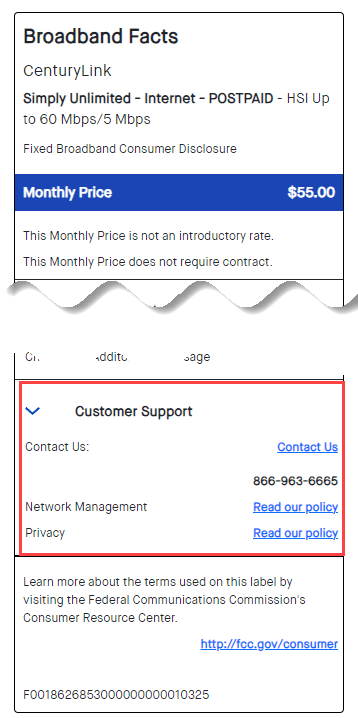
Customer support
This is where you can find contact information for Customer Service and our Network Management and Privacy Policies. In the final section, you'll see a link to the FCC's website and the unique identification number for your plan.
- Facts
- Charges and terms
- Other fees
- Discounts and bundles
- Speeds
- Data
- Support
Key terms for the Broadband Label
You may see these terms on the Broadband Label.
HSI: High-Speed Internet
Gbps: Gigabits per second
Mbps: Megabits per second
ms: Milliseconds
Modem or Gateway/SmartNID: The equipment that connects your property to our network
Premium WiFi Pods: A mesh network that blankets your property with a strong connection
Broadband Label FAQs
Fixed broadband provides the most reliable wireless access but is limited to a fixed location (ie. your home). Fixed broadband connections also tend to be faster and cheaper than a mobile connection. Mobile broadband allows you to take your wireless access with you wherever you go but can vary greatly in reliability of connection.
With a purchased modem, you'll pay a one-time initial equipment fee. With a leased modem, you'll pay a monthly service charge for the use of our equipment. While both options are listed on the nutrition label for you to compare, you will only be charged for the option you choose.
Standard installation is available for certain speeds and internet technologies. It includes the activation of the internet service outside of the premises by a technician with the convenience of no appointment.
Technician installation is required for certain speeds and internet technologies. It includes delivery and installation of equipment by the technician, connection of one wired device and one wireless device, and the replacement, repair, or installation of a jack that connects to the internet. Most fiber internet service requires a technician installation.
One-time charges are costs for things that don't occur monthly. These may include equipment and installation charges based on the internet technology and speed that will connect your property.
For more details on the different types of equipment click here.
For more information on installation, click here.
You'll see Broadband Information Labels as you're ordering new service. You'll get an email that contains the information label. After you've purchased service, you can find your information label when you sign in to your CenturyLink account online.
FCC has created a format similar to FDA food nutrition labels, requiring companies to provide the following information in this order:
- Provider name
- Plan name
- Contract plans
- Whether it’s a fixed or mobile internet plan
- Plan price (including whether it’s an introductory rate and length of rate)
- Additional charges, fees, and taxes
- Discounts and/or bundle offers available for the plan
- Typical download speed, upload speed, and latency
- Applicable data caps and limits
- Network management and privacy policy links
- Customer support contact information
- Link to the Federal Communication Commission’s website
- Plan’s unique identification number
Speed and performance FAQs
Internet speeds are measured in megabits per second (Mbps). The numbers you see on our information labels are reflective of the wired speeds you can typically expect our network to deliver to your home. These numbers are determined through regular internal testing of our system.
Latency, also referred to as ping, is the amount of time it takes for your network to transfer information from your computer to a remote server and back. There will always be some latency over your network, but the lower this number, the better your performance.
Latency is measured in milliseconds. The numbers you see on our internet labels are reflective of the connection response time you can typically expect our network to deliver to your home. These numbers are determined through regular internal testing of our system.
Your download speed shows how fast information transfers to you over the internet. Places you might notice download speed include updating games and other installed programs or downloading files and photos.
Your upload speed shows how fast information transfers from you to its destination on the internet. Places you might notice upload speed include video calls or uploading files and attachments.
In addition to the speed of the plan you sign up for, many factors can impact your speeds, including but not limited to:
- Type of equipment (router, computer, cell phone, tablet, gaming console, etc.)
- Age of equipment
- Number of connected devices
- Distance of equipment from router/modem (WiFi connections)
- Wired vs wireless connection (You’ll always get the strongest connection by hard wiring to your router.)
- Walls or solid objects (Their placement could be blocking your WiFi signal.)
- Electronics interference (microwaves, Bluetooth devices, cordless phones, baby monitors, etc.)
CenturyLink Broadband Label catalog
On the catalog page, we provide all of our label information in a machine-readable, CSV format, allowing customers and third parties to more easily collect and compare data.
Related Topics
Top Tools
Was this information helpful?
Support topics






.png)





